
Sir Terence David John Pratchett was an English humourist, satirist, and author of fantasy novels, especially comical works. He is best known for his Discworld series of 41 novels.

The Unseen University (UU) is a school of wizardry in Terry Pratchett's Discworld series of fantasy novels. Located in the fictional city of Ankh-Morpork, the UU is staffed by a faculty composed of mostly indolent and inept old wizards. The university's name is a pun on the Invisible College, and many aspects of the University are references to Oxford and Cambridge University. The exploits of the head wizards of the Unseen University are one of the main plot threads in the long-running fantasy series, and have played a central role in 13 novels to date, as well as the four supplementary Science of Discworld novels and the short story, A Collegiate Casting-Out of Devilish Devices.

Sourcery is a fantasy novel by British writer Terry Pratchett, the fifth book in his Discworld series, published in 1988. On the Discworld, sourcerers – wizards who are sources of magic, and thus immensely more powerful than normal wizards – were the main cause of the great mage wars that left areas of the disc uninhabitable. As eight is a powerful magical number on Discworld, men born as the eighth son of an eighth son are commonly wizards. Since sourcerers are born the eighth son of an eighth son of an eighth son, they are wizards squared. To prevent the creation of sourcerers, therefore, wizards are not allowed to marry or have children. The first few pages of the novel deal with a sourcerer's father who cheats death by making a prophecy that Death must honour; the alternative is to risk destroying the Discworld. The rest of the novel deals with the sourcerer's plan to have wizards rule the Discworld, and the efforts of a small group – including Rincewind the Wizard, Nijel the Destroyer and Conina the Hairdresser, daughter of Cohen the Barbarian – to thwart those plans.
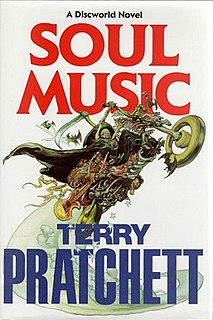
Soul Music is a fantasy novel by British writer Terry Pratchett, the sixteenth book in the Discworld series, first published in 1994. Like many of Pratchett's novels it introduces an element of modern society into the magical and vaguely late medieval, early modern world of the Discworld, in this case Rock and Roll music and stardom, with near disastrous consequences. It also introduces Susan Sto Helit, daughter of Mort and Ysabell and granddaughter of Death.
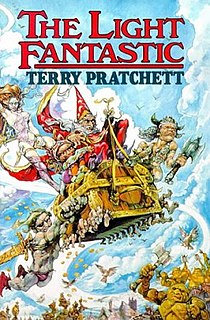
The Light Fantastic is a comic fantasy novel by Terry Pratchett, the second of the Discworld series. It was published on 2 June 1986, the first printing being of 1,034 copies. The title, taken from a poem by John Milton, in which it refers to dancing lightly with extravagance.

Equal Rites is a comic fantasy novel by Terry Pratchett. Published in 1987, it is the third novel in the Discworld series and the first in which the main character is not Rincewind. The title is wordplay on the phrase "Equal Rights".

Susan Sto Helit, once referred to as Susan Death, is a fictional character in Terry Pratchett's Discworld series of fantasy novels. She is the granddaughter of Death, the Disc's Grim Reaper, and has a number of his abilities. She appears in three Discworld novels: Soul Music, Hogfather, and Thief of Time. Being both human and supernatural, Susan is frequently and reluctantly forced away from her attempts at "normal" life to do battle with malign supernatural forces or to take on her grandfather's job in his absence. Death tends to rely on her in his battles against the Auditors of Reality, particularly in situations where he has no power or influence. As the series progresses, she also begins to take on roles educating children, so that, as Pratchett mentions in The Art of Discworld, she has "ended up, via that unconscious evolution that dogs characters, a kind of Goth Mary Poppins".
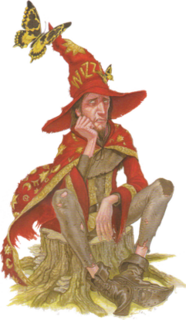
Rincewind is a fictional character appearing in several of the Discworld novels by Terry Pratchett. He is a failed student at the Unseen University for wizards in Ankh-Morpork, and is often described by scholars as "the magical equivalent to the number zero". He spends most of his time running away from bands of people who want to kill him for various reasons. The fact that he's still alive and running is explained in that, although he was born with a wizard's spirit, he has the body of a long-distance sprinter. Rincewind is also renowned for being able to solve minor problems by turning them into major disasters. His unique "skill" is implied to be due to being the chosen one of "The Lady", the anthropomorphic personification of luck.
A major subset of the Discworld novels of Terry Pratchett involves the witches of Lancre. The three main witches introduced in 1988's Wyrd Sisters — crone Esme Weatherwax, mother Nanny Ogg and maiden Magrat Garlick — are a spoof on the Three Witches in Shakespeare's Macbeth, and a tongue-in-cheek reinterpretation of the Neopagans' Triple Goddess. The three witches are portrayed as more sensible and realistic than the often-foolish residents of the Discworld, and Granny Weatherwax "especially tends to give voice to the major themes of Pratchett's work."

Interesting Times is a fantasy novel by British writer Terry Pratchett, the seventeenth book in the Discworld series, set in the Aurient.
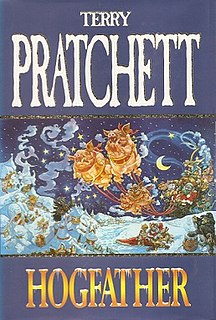
Hogfather is the 20th Discworld novel by Terry Pratchett, and a 1997 British Fantasy Award nominee. It was first released in 1996 and published by Victor Gollancz. It came in 137th place in The Big Read, a BBC survey of the most loved British books of all time, making it one of fifteen books by Pratchett in the Top 200.
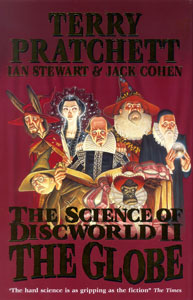
The Science of Discworld II: The Globe is a 2002 book written by British novelist Terry Pratchett and science writers Ian Stewart and Jack Cohen. It is a sequel to The Science of Discworld, and is followed by The Science of Discworld III: Darwin's Watch.

The Science of Discworld is a 1999 book by novelist Terry Pratchett and popular science writers Ian Stewart and Jack Cohen. Three sequels, The Science of Discworld II: The Globe, The Science of Discworld III: Darwin's Watch, and The Science of Discworld IV: Judgement Day, have been written by the same authors.

Death is a fictional character in Terry Pratchett's Discworld series and a parody of several other personifications of death. Like most Grim Reapers, he is a black-robed skeleton who usually carries a scythe. His jurisdiction is specifically the Discworld itself; he is only a part, or minion, of Azrael: the universal Death. He has been generally used by Pratchett to explore the problems of human existence, and has become more sympathetic throughout the series.

The Discworld is the fictional setting for all of Terry Pratchett's Discworld fantasy novels. It consists of a large disc resting on the backs of four huge elephants which are in turn standing on the back of an enormous turtle, named Great A'Tuin as it slowly swims through space. The Disc has been shown to be heavily influenced by magic and, while Pratchett has given it certain similarities to planet Earth, he has also created his own system of physics for it.
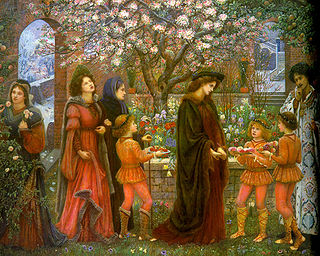
A magician, also known as an enchanter/enchantress, mage, magic-user, sorcerer/sorceress, spell-caster, warlock, witch, or wizard, is someone who uses or practices magic derived from supernatural, occult, or arcane sources. Magicians are common figures in works of fantasy, such as fantasy literature and role-playing games, and enjoy a rich history in mythology, legends, fiction, and folklore.

Terry Pratchett's The Colour of Magic is a fantasy-comedy two-part television adaptation of the bestselling novels The Colour of Magic (1983) and The Light Fantastic (1986) by Terry Pratchett. The fantasy film was produced for Sky1 by The Mob, a small British studio, starring David Jason, Sean Astin, Tim Curry, and Christopher Lee as the voice of Death. Vadim Jean both adapted the screenplay from Pratchett's original novels, and served as director.
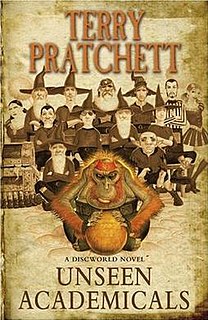
Unseen Academicals is the 37th novel in Terry Pratchett's Discworld series. The novel satirises football, and features Mustrum Ridcully setting up an Unseen University football team, with the Librarian in goal. It includes new details about "below stairs" life at the university. The book introduces several new characters, including Trevor Likely, a street urchin with a wonderful talent for kicking a tin can; Glenda Sugarbean, a maker of "jolly good" pies; Juliet Stollop, a dim but beautiful young woman who might just turn out to be the greatest fashion model there has ever been; and the mysterious Mr Nutt, a cultured, enigmatic, idealistic savant. According to the publisher, Transworld, the "on sale" date for the hardback was 1 October 2009 although the official publication date is 8 October 2009. Bookshop chain Borders included a small set of exclusive Discworld football cards with each book.

Discworld is a comic fantasy book series written by the English author Terry Pratchett, set on the Discworld, a flat planet balanced on the backs of four elephants which in turn stand on the back of a giant turtle. The series began in 1983 with The Colour of Magic and continued until the final novel The Shepherd's Crown, which was published in 2015, following Pratchett's death. The books frequently parody or take inspiration from classic works, usually fantasy or science fiction, as well as mythology, folklore and fairy tales, and often use them for satirical parallels with cultural, political and scientific issues.
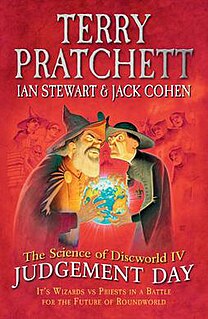
The Science of Discworld IV: Judgement Day is a book set on the Discworld, by Terry Pratchett, Ian Stewart and Jack Cohen. It is the sequel to The Science of Discworld, The Science of Discworld II: The Globe and The Science of Discworld III: Darwin's Watch.


















